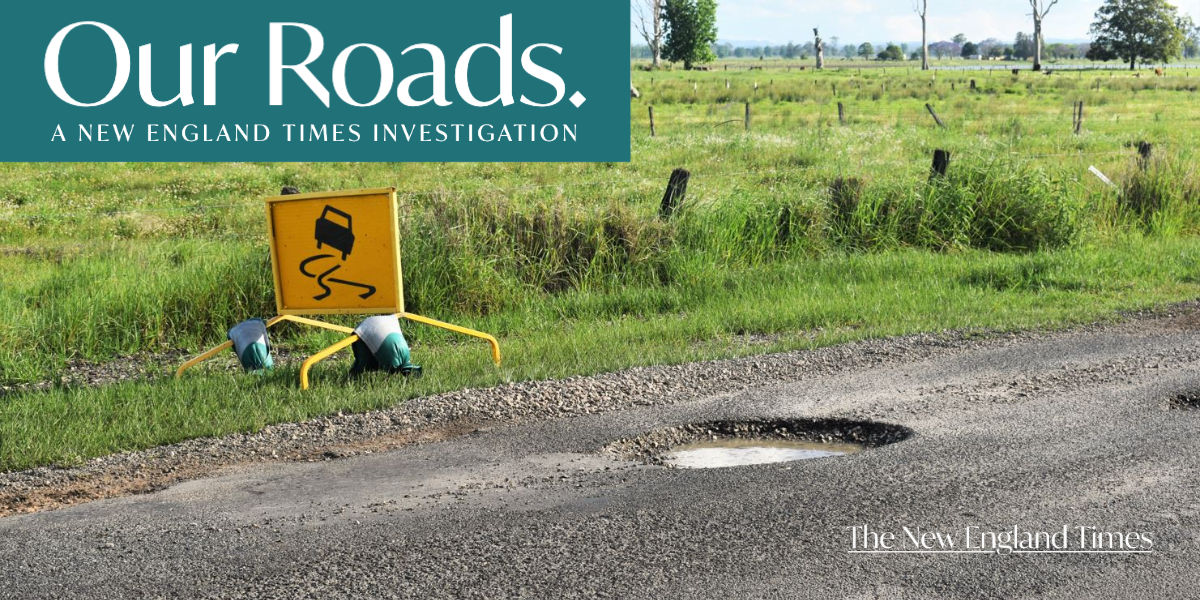This is the third and final part of our series looking at our flood damaged roads and what’s being done to fix them. Read Part 1 and Part 2.
Here’s a riddle for you: when is $500 million not half a billion dollars?
Answer: when it’s government funding.
As impressive as the $500m announcement was in news headlines, the reality is that there is no guarantee that will be the amount spent on fixing our flood damaged roads, and there is no guarantee our local governments will see a dollar of it.
The complexities of how government funding works bamboozles many who work in the system, but a simple explanation is this:
Step 1: The flashy political announcement that money will be made available for something is really just that – an announcement. Think of it like getting engaged, it’s a serious commitment, but no one is legally obliged to go through with it.
Step 2: Once the announcement is made, the department managing the money – for roads funding that’s usually Transport for NSW – will then open up the grant to applications, defining all the rules and eligibility criteria. This is effectively an invitation for eligible organisations or individuals, in this case local councils, to apply for a share in the bucket of money the politicians have flagged for that purpose.
Step 3: Local councils then need to prepare often very detailed applications that say what they want to use the money for, and submit those applications to the relevant department. This will include specifics of what road they want to fix, what kind of repair they want to do, and how much they are going to spend on the work.
Step 4: The department administering the grant then assesses the application, a bit like a banker assesses a home loan. If it’s a good investment, presents value for money, and so on, they will award the grant. If it’s not a good proposal, then the department may work with the council to change the application to something they consider more appropriate, or reject the application.
So while the politicians have announced they’re giving the money, and that they’re fast-tracking it to get it in to your council’s bank accounts faster, the bureaucracy still needs to do their thing.
There are pros and cons in this: the major pro is that it helps to prevent corruption and ensures tax payer dollars are used wisely; the major con being that it’s slow. Gunnedah Shire Council has already warned their residents that a couple of smaller roads may be closed for months while they wait for Transport for NSW approval.
So how much money is available?
Good question. It’s often difficult to tell whether an announcement of funding includes amounts already announced, or whether it’s completely new money, and there’s been so many announcements of late it’s hard to tell whats what. So, we asked Transport for NSW what the total amount of money that councils can expect to share in, and they weren’t too sure themselves, as until the grants are actually paid out they don’t know what the final figure is.
If you want a recent example of why that’s the case, consider the Morrison Government’s $4.8 billion emergency response fund… that only spent managed to deliver about $100 million to people trying to recover from fire and floods. So it’s actually a good thing that Transport for NSW didn’t want to put a dollar figure on how much will be paid out – because that’s the honest answer, they don’t know yet.
Last night’s Senate Estimates revealed Scott Morrison’s $4.8 billion disaster fund has STILL not spent a cent on disaster recovery, STILL not started building a single disaster readiness project, but it HAS earned his Government over $800 million in interest. pic.twitter.com/DUwHCsglaZ — Senator Murray Watt (@MurrayWatt) February 14, 2022
A spokesperson for Transport for NSW told the New England Times both the $50 million and the $500 million programs are in addition to existing funding and assistance to councils including the Regional Roads Block Grant program and NSW Disaster Assistance Arrangements.
So, it’s new money, not reannounced, that’s good too.
The $50m has already been paid out and the maximum each council could get was based on the size of each council’s road network. This is how much each council in the New England North West and surrounding areas got to fix the potholes:
- Armidale Regional Council $265,448.66
- Ballina Shire Council $215,600.63
- Bellingen Shire Council $208,306.80
- Clarence Valley Council $849,964.53
- Coffs Harbour City Council $305,053.05
- Coonamble Shire Council $552,874.95
- Glen Innes Severn Shire Council $395,357.10
- Gunnedah Shire Council $504,644
- Gwydir Shire Council $709,204.63
- Inverell Shire Council $794,626
- Kempsey Shire Council $433,024.71
- Kyogle Council $415,229.69
- Lismore City Council $421,640.98
- Liverpool Plains Shire Council $511,186.12
- Moree Plains Shire Council $927,639.40
- Nambucca Valley Council $250,009.36
- Narrabri Shire Council $739,849.70
- Port Macquarie – Hastings Council $479,315.11
- Richmond Valley Council $365,343.89
- Tamworth Regional Council $1,111,429.74
- Tenterfield Shire Council $578,523.54
- Upper Hunter Shire Council $591,431.97
- Uralla Shire Council $316,306.28
- Walcha Council $314,554.94
- Walgett Council $1,211,173.88
- Warrumbungle Shire Council $864,682.68
The $500 million Regional and Local Roads Repair Program opened on 11 January 2023 and applications will close on 20 January 2023. Local governments across the state can apply for a portion of the new $500 million funding and will be allocated a maximum amount based on their total kilometres of local and regional roads, just as the initial $50m was. So rough rule of thumb, times the above amount by 10, and that’s roughly what your local council can apply for… but it’s still up to Transport for NSW to decide to give it or not.
But they will get the money, right?
Fortunately, all local councils are very good at this process and most have dedicated staff who just do all the grant applications. It would be unusual for the requested grants not to be awarded. The intention of the government is clear to deliver this large amount of money quickly into the bank accounts of council, and Transport for NSW will deliver on this as well as they can.
“This funding will deliver funds directly to councils – including those in the New England, north west and north coast regions of NSW – that have been hit hard by recent unprecedented rain and storms which ravaged local roads,” the spokesperson for Transport for NSW said.
Note too that not all roads funding money is managed by the ‘everyone gets their share’ approach of dollars per kilometre.
“Under NSW Disaster Assistance Arrangements, money is not traditionally allocated as per other funding programs.”
“The amount spent by councils is dependent on the damages experienced by each individual road within a Local Government Area after an area has been declared as a Natural Disaster.”
The spokesperson for Transport for NSW added: “Individual councils work closely with Transport for NSW assessors and engineers in order to assess natural disaster claims as they are submitted. In total more than $21 million has been paid to councils for Natural Disaster Recovery Work in 2022, with this amount split over several disaster declarations.”
There have been six disaster declarations related to recent floods, and the $21,316,280 paid out for the necessary repairs in those disaster areas is on top of the $550m in pothole funding.
Is it enough?
Undoubtedly, the answer to this question is no. It will go a long way and all councils are grateful for it, but it won’t get all the roads up to scratch. That would cost closer to $1.9 billion according to the NRMA.
Councils, while confident of getting the work done, and grateful for the extra funding, are clear they need a lot more than what has been offered so far.
“This funding, in addition to other grant funding Council has received for specific projects, will go a long way to addressing most, if not all, of the specific areas of damage on our road network from the 2022 flooding. But bringing the overall asset condition of our network up to standard is much longer term challenge that will require continued additional revenue to be sought into the future,” said Walcha Council.
Glen Innes Severn Shire Council said “it’s a great start, but we need at least fifteen times that much to address the worst impacts of the wet season.”
Liverpool Plains Shire Council indicated the same. “No [it’s not enough]. Council has identified in excess of $15 worth of pavement deterioration on our road network over the last 12 months.”
Same deal in Inverell. “The cost of this damage has been estimated to cost $12m to bring the roads back to satisfactory condition,” Inverell Shire council said.
Earlier today NSW Farmers issued a challenge to the NSW Government to match a billion-dollar Western Sydney roads funding package across regional NSW.
NSW Farmers Vice President Rebecca Reardon said there was an even greater need to fix country roads, and called for far greater funding – and resources – to tackle the problem properly.
“We’ve seen funding promised to local councils to repair potholes – but the damage is significant – multiple patching of the road surface is not going to increase safety,” Mrs Reardon said.
“Our backroads have become defacto highways over the past year and while there have been some big-ticket announcements, there are no clear plans of how to tackle this very serious issue that’s impacting safety and livelihoods.”
“The damage has led to increased traffic on regional roads at a time when harvest vehicles also need to move safely, and we will continue to raise this issue until we get a solution.”
Local council leaders have also called for the federal government to match the funds.
Got something you want to say about this story? Have your say on our opinion and comment hub, New England Times Engage


